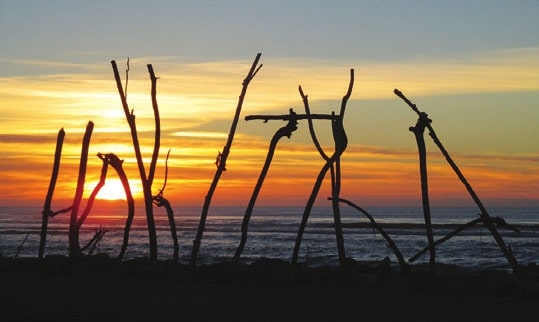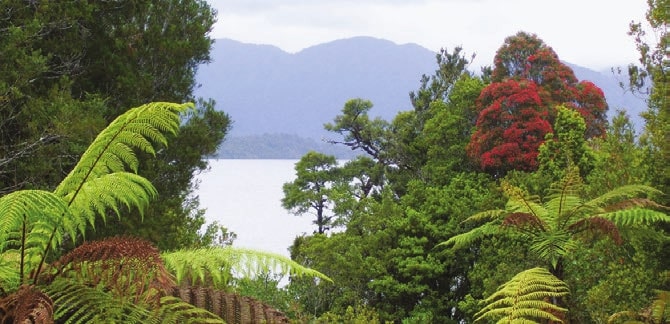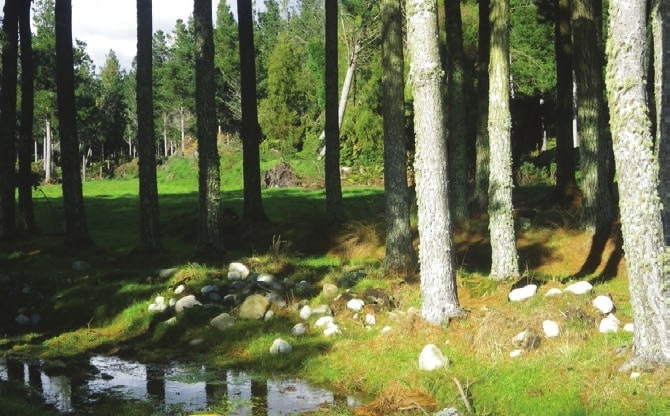The West Coast - forests galore
Michael Orchard, New Zealand Tree Grower February 2016.
The national conference is only a couple of months away, staring on 21 April in Hokitika. If you have not already booked your place, do it now using the registration form enclosed with this issue of Tree Grower. This article tells you more about the conference to add to the information in the November Tree Grower. It is going to be another excellent conference so make sure you register promptly.
Spread between wild coastlines and soaring mountain tops, bounded by fierce rivers and gentle black streams, is an ecological habitat and resource of high renown – The West Coast forest. From the air it can seem magical and endless, from the ground tall and impressive, a multitude of species and shapes of vegetation. It is rainforest of subtropical and temperate varieties, from warm and wet, to cold and snowy, with a lot of wetland, shrubland and flax swamps in between.
Water in the form of rain is our greatest asset, but also a liability, having leached the soils of much of their valuable nutrients over thousands of years, creating podsols and iron pans. Like many of the other remaining great forests of the world, you come to realise just how much of the fertility of such sites is above ground in the vegetation and forest humus itself. Rimu, kahikatea, totara, matai, rata, beech and other hardwoods dominate the forest canopies.
Along the more fertile valleys new colours of green, emerging open spaces of farmland, and clusters of rural settlements, tell of its colourful history of sawmilling and mining, and especially of its communities – the West Coast people.


Conference invitation
It is to this wild and invigorating land that we again invite you to the 60th National Farm Forestry Conference in Hokitika. We hope to impart much of the richness and history of the region and its forestry history. This will include visiting the Hokitika Industrial Heritage Park, Hokitika Museum, Shantytown, Reefton, the Tree Top Walkway and the National Kiwi Centre, along with walks in virgin and managed forest areas, new and existing exotic forest plantings, traditional farming shelter and familiarisation with our new dairying industry. Conservation and tourism too reflect our new growth opportunities.
Private enterprise has continued the desirable native forest production management goal, with important American financial backing for a Reefton based sawing and veneer production mill. This was only possible due to the availability of a number of sizeable private beech forest sustainable production areas. We will be visiting the mill which uses beech and windfall rimu while having the capacity for producing veneer from eucalypt and other species for special projects.
This is our last formal conference event before dinner in Reefton. Before this we will visit the Ferguson’s Waipuna farm and forestry property to examine sustainable native forest management and conservation in the field.
No visit to look at West Coast land use would be complete without an understanding of the dairy farming industry. We have therefore arranged for a special visit to Blair’s dairy unit, inland from Greymouth, part of a 7,000 hectare spread owned and managed by Landcorp NZ. It is divided into five dairy units and one deer and dairy support unit, carrying 11,000 animals at the peak of the season. From your conference lunch tables you will be able to look down our main street in Hokitika to see the Westland Milk Products processing factory, employing around 200 people on a site which has just opened a new nutritional plant for higher value specialist milk powder exports.
Practitioners and challenges
The West Coast story follows that of much of New Zealand, except that in contrast to other regions most was vested in Crown ownership often with difficult or remote access. Even today around 85 per cent of the land area remains as natural vegetation managed by the Department of Conservation. Therefore, apart from concessionaire income generated by this natural indigenous resource, people on the West Coast must find a way of making income from the remaining 15 per cent. Previously cut-over native forest regenerate rapidly to original type, so native trees are here to remain in the landscape, teaching us a lot about forests and forest ecology on a broad scale. In the valleys and across the flood plains are private native forest stands and remnant links with exotic woodlots. This production landscape is dominated by the larger previously Crown established exotic forests, now Maori owned, and the ever expanding dairy farming industry. At the conference we aim to visit representative examples of all of these.
The challenge for today’s farm foresters and farmers is to make wise land use decisions, recognising the often long time frames necessary for trees to grow, especially in an era when rate of return on assets and timing is all important. Land clearing, draining, fencing and soil improvement will continue on the West Coast as part of an intensification of land use on our better soils. Existing plantation areas are likely to be replanted, encouraged by forestry rules and carbon emission regulations.
High quality timber
Education on the biodiversity value and silvicultural production potential of residual private native forest will be important, as well as understanding the ecology and management needs of their own forests. It is only these private indigenous stands that will be allowed to provide a small continued supply of sustainable New Zealand heritage timbers for future generations.
Balancing the uneven age class distribution of earlier West Coast plantation forests will be a challenge, but there are many back country areas where planting on rougher rolling country, adjacent to intensively cultivated land, has future potential. The West Coast regime has been proved already from our first rotation to grow high quality large diameter pruned pines for white high grade furniture quality timber and peeler markets, as there are no distant markets for small wood from here. The economic value of firewood as a good by-product is not to be underestimated.

During the conference, building on the success of older stands of special purpose species also harvested, we will look at the potential of the new species now established on members’ properties and elsewhere. These include blackwood, cypress and eucalypts, with trials of many other species. We hope you will find stands well worth the visit along with the forestry knowledge they can impart.
Research
Research knowledge is often the cornerstone of successful forestry. We all need enquiring minds to do this, we need to allocate sufficient funds from our production activities towards the agreed projects, we need professional input and good scientific method to achieve it, and finally we need good communicators to realise its value. Scion is a good supporter of the NZFFA, and will present some of their latest research findings in the field and in the conference centre.
Scion staff will speak on −
- GE forestry, passing on information about the opportunities arising from new breeding technologies
- Ecosystem services, value beyond the trees and what other services that natural and planted forests provide
- Small forest owners survey analysis presentation of findings, around information, technology and communication.
Additionally, in the field, Scion have useful information to present to second rotation forest owners. On the trip south may also be the opportunity to discuss blackwood knowledge at our visit site near earlier Scion research establishment trials.
Concluding note
It just remains now for me, on behalf of our 2016 Conference committee and our West Coast Farm Forestry Branch, to invite and welcome you to visit us in April for a time of fun, learning and meeting old friends and making new ones. You can preview some of our visit sites on the Trees on Farms videos available on line, or check out the 2010 May or November editions of Tree Grower with a West Coast series of articles.
Do not forget your insect repellent, gumboots, coats, cameras, hats and sunscreen. As we have just celebrated 150 years of Hokitika township since it was cut out of the tall virgin rimu rainforest, why not read the best-selling novel The Luminaries by Eleanor Catton to begin the experience.
If you have not already done so, fill out the enclosed registration form or use the website to book your place at the conference.

 Farm Forestry New Zealand
Farm Forestry New Zealand